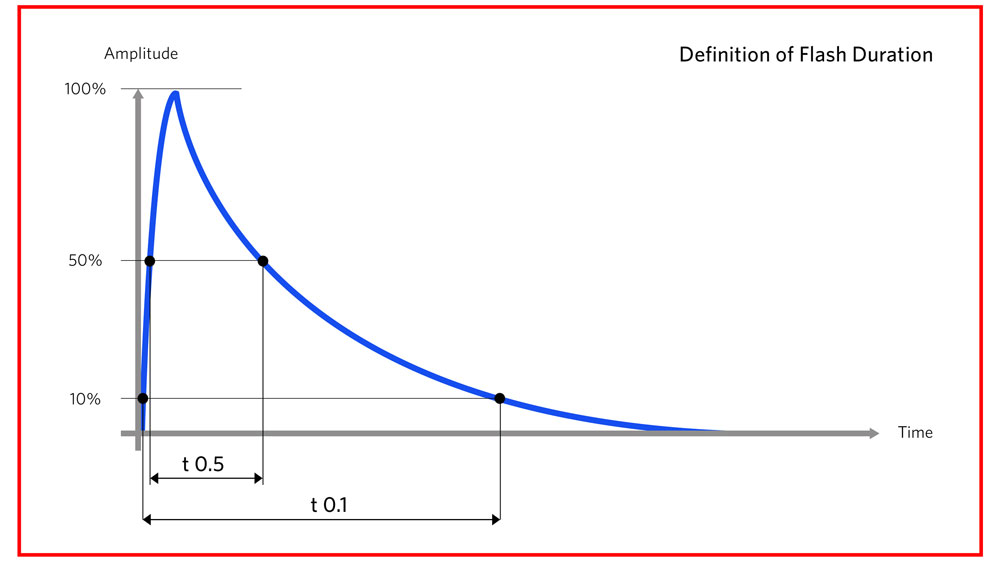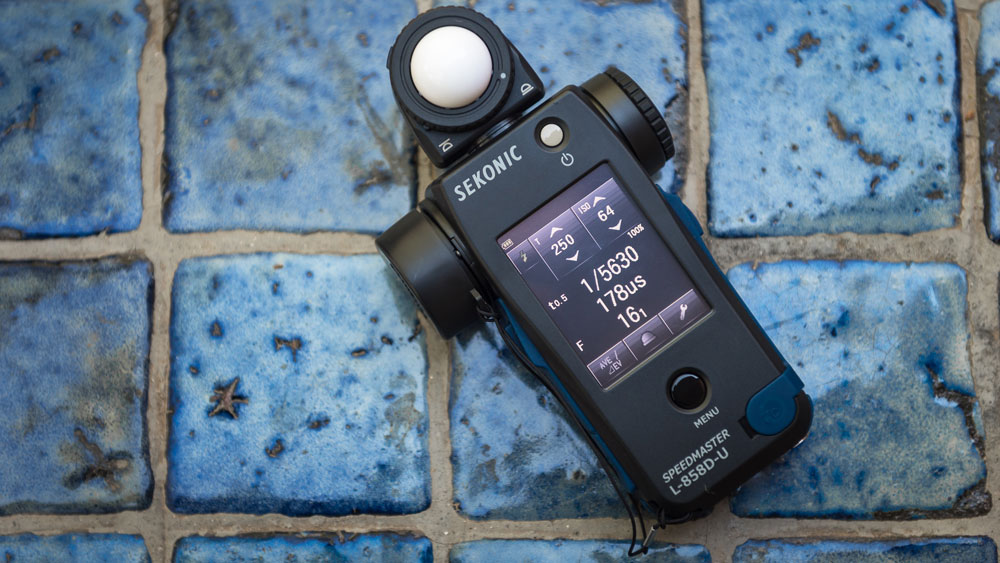Understanding Flash Duration

The Flash Duration for any strobe or flash is technically the length of time that the flash tube emits light for a single burst. As simple as that sounds, be aware that almost no flash or strobe company will tell you how long the actual flash duration lasts. Instead most companies quote what are known as the t0.5 or the t0.1 flash duration specifications, which I will define here in just a moment. These flash duration specifications are part of the standards for a “discharge duration” as defined by the International Organization for Standardization (ISO). Aside from these ISO standard specifications, the reason strobe companies don’t disclose the total flash duration is that the flash does not have a constant intensity over its entire duration. As in Figure 1 below, the flash intensity is brightest just after the flash is triggered and then generally decreases as shown in the curve below:

As you can see the t0.5 value is the period during which the flash intensity is above 50% of its maximum brightness. The t0.1 value is the period during which the flash intensity is above 10% of its maximum brightness. Hence, the t0.1 value is a much more accurate assessment of the actual flash duration.
The t0.5 specification is the period during which the flash intensity exceeds 50% of its maximum brightness. What this means is that 50 % of the light is emitted after the t0.5 threshold is met. Hence, as you can see from the chart above, the actual flash duration can be significantly longer than the t0.5 specification. What this means for the photographer is that there is still a lot of light being emitted after the t0.5 threshold and thus there is the possibility for motion blur in the image. For sports photographers, or any photographers trying capturing fast moving subjects using flash, this is a major issue and the reason an in-depth understanding of flash durations is so important.
Because the meaning of the t0.5 specification is somewhat ambiguous, the ISO governing body set the t0.1 duration as the “total flash duration.” The t0.1 specification is the period during which the flash intensity exceeds 10% of its maximum brightness. As you can see in Figure 1 above, the t0.1 value is significantly more informative and much closer to the actual duration of the flash.
These two separate flash duration values allow us to compare the flash duration of various strobes fairly accurately. For the photographer that shoots sports, dance, or anything that moves quickly, selecting a strobe with a very short flash duration is a must if you want to freeze a subjects motion with a flash or strobe. Most manufacturers offer strobe kits with extremely short flash durations that are marketed specifically to sports and action photographers. Some strobe companies even have flash cut-off technology built into their power packs, which reduces the flash duration significantly

These two images show the effect of flash duration on a moving subject, which is this case was a bicycle wheel rotating with some serious speed. In the upper image, the t0.5 flash duration (as measured on the Sekonic L-858D-U) was 1/353 second, which is pretty slow as flash durations go. Because of the slow flash duration the bicycle wheel is blurred. In the lower image, the t0.5 flash duration was 1/5,350 second, which is a decently fast flash duration and hence, the wheel is frozen.
After going through all of these numbers and specifications, it can be a bit dizzying to figure out how fast a flash duration you actually need. In general, a t0.5 value of 1/2000th second or higher will be more than adequate for most photographers who need to freeze the motion of a moving subject. For faster moving subjects a faster flash duration will be needed.

This multiple-exposure image of Luis F. Castillo shadow boxing at Undisputed Fitness in Santa Fe, New Mexico was captured on a black background using a very fast flash duration to stop his motion has he bounced around and punched the air. The multiple exposure was created in-camera using Nikon’s multiple exposure feature. Tech Specs: Nikon D810, Nikkor 70- 200mm f/2.8 lens, 1/250 second at f/8, ISO 64, Elinchrom ELC 1000 HD strobes and modifiers.
In contradiction to the above paragraph, the latest Hi-Sync and HS technologies allow for using shutter speeds above the maximum flash sync speeds of most DSLRs. This means we can stop the action, and still sync with a strobe, using a high shutter speed like 1/8,000th second, to stop the motion of an athlete instead of using a fast flash duration. HS technology requires a slow flash duration, typically less than 1/800th second, to work properly, which can be quite confusing. Nevertheless, regardless of what technique and technology is being used, knowing the actual flash duration is always an important factor when working with a moving subject

The Sekonic L-858D-U, as shown here, can measure the flash duration of any strobe or flash. It can also be set to measure the t0.5 or the t0.1 flash duration. And of course it can also measure ambient exposures, flash exposures and also High Speed Sync (HSS) flash exposures—all of which makes it the most powerful and versatile light meter on the market.
Sadly, most flash manufacturers don’t tell you the flash duration for each power setting, though some have this information in the manual that comes with the flash. A few manufacturers display the actual flash duration for that exact power setting on the flashes LCD readout, which is very handy. But these numbers aren’t always accurate and the actual real-world flash durations can vary widely from flash to flash. Because of this, using a light meter like the Sekonic L-858D-U, which can very accurately measure the flash duration, as well as the light output, is quite helpful. Using a light meter like the Sekonic L-858D-U will help to reign in control of the actual the flash duration.
